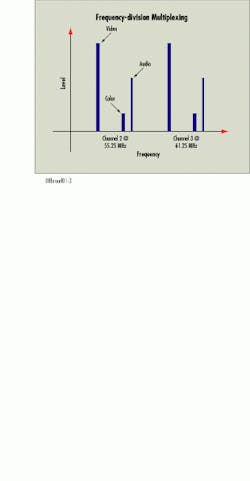WDM and the evolution of "broadband"
WDM and the evolution of "broadband"
Once you understand the concept of "broadband," you can appreciate just how much bandwidth WDM can provide cable-TV companies.
Donald T. Gall and Mitch Shapiro
Since this column carries a "broadband" label, it seems appropriate to consider the meaning of the term.
The term is something of a misnomer when considered in the context of the total communications spectrum. Technically speaking, any network that uses multiple frequencies can be called "broadband." In the early days of cable television, a "broadband" system that carried five analog television channels was state-of-the-art, whereas today`s systems can carry several hundred channels (the exact number depends on several factors). To put these "broadband" systems in perspective, consider that the entire radio frequency (RF) spectrum used for communications until fiber optics came along can today be duplicated many times in either the 1310- or 1550-nm windows.
Figure 1 depicts the modern frequency spectrum approximately to a linear scale, with the portion of the spectrum below 1 THz drawn to scale and the portion above 1 THz labeled in equivalent inches. Because most graphic representations of this type use a logarithmic scale, they tend to mask the dramatic differences in bandwidth between the RF and optical domain, which are more evident in the near-linear scale provided in the figure.
There are several ways to maximize information in a communications network. One can: (1) stack it closer together in time, a process known as time-division multiplexing; (2) stack it in different parts of the network bandwidth, which is frequency-division multiplexing (fdm); or (3) concentrate it by breaking the information down into smaller blocks by applying a mathematical formula. The use of fdm is typically what qualifies a network as "broadband." Recent developments in cable-television networks have come about largely from developments in digital technology that have made the use of all three techniques feasible from a business and technical standpoint.
The broadband network bandwidth scheme that has been adopted by most of the cable industry is shown in Figure 2. Most cable operators are planning to have between 80 and 96 analog channels, with the remaining bandwidth dedicated to digitally compressed multimedia.
Figure 3 provides an expanded view of the frequency spectrum where Channels 2 to 6 reside--the original channels used by the broadcast industry and early cable-television networks. The figure shows the relationship between video, audio, and color information as well as the next adjacent channel.
There are a lot of parallels between the early days of cable television and the history of dense wavelength-division multiplexing (dwdm). As mentioned earlier, the first cable networks had very few channels. The coaxial cable broadband pipe, however, has always had significantly more bandwidth than could be supported by the available electronics.
The same is true of fiber optics, but on a much larger scale. Figure 4 depicts two laser frequencies 10 nm apart. Not very long ago this was a cutting-edge configuration. If we talk about the same two wavelengths in broadband terms, these frequencies are 2230 times farther apart the entire useable coaxial-cable spectrum.
Laser-frequency stability and dwdm devices are on a rapid development curve. dwdm systems are being deployed today with eight to 16 wavelengths. The cable industry has not widely taken advantage of these developments, mainly because they have not needed the additional capacity. As discussed in last month`s column, however, tci (Denver, CO--recently acquired by at&t) plans to use the technology in its analog transport architecture.
Most fiber technology was first designed for digital applications. The cable industry, starting in the mid-1980s, worked with manufacturers to adapt the various electronic and passive devices for analog circuits.
In analog circuits, the overall link budgets are much shorter. The information sent through the network includes the original components as well as noise and distortions added along the way. To compensate for this, the received optical power must be considerably higher than its digital counterpart. The impact of a multiple dwdm multiplexer/demultiplexer can be significant. A typical 1550-nm analog fiber link has an upper power limit based on simulated Brillouin scattering. This limit is approximately 16 dBm in currently available analog equipment. At the receive side, the optical power input is designed for 0 to 2 dBm, which yields a maximum link budget of 16 dBc. If we insert two dwdm devices with 4 dBc of insertion loss each, we halve the calculated network reach! Erbium-doped fiber amplifiers can help alleviate this problem, but they add noise and distortion products to the network.
Another problem in the analog domain is the 4-wave mixing phenomenon. There is a similar distortion found in analog RF electronics called composite second order (cso), where network frequencies will create sums and difference images that add to the original signals. Over the years, cso and other types of signal-quality impairments have been analyzed and minimized. Efforts continue within both the fiber-optic and cable industries to make further improvements in these areas.
A fundamental reality is that almost every fiber-optic electronic and passive device requires some modification in technical specifications to work efficiently in an analog network. The good news is that, given its recent and expected growth, the "broadband" market is large enough to warrant the necessary attention. uFig. 4. Wavelength-division multiplexing promises huge amounts of bandwidth, in broadband terms. These laser wavelengths are 2230 times farther apart then the entire useable coaxial-cable spectrum.




